1.3: Inclusión
- Page ID
- 50196
Cuando hablamos de educación inclusiva para la primera infancia, estamos hablando de programas diseñados para niños y familias de una amplia gama de antecedentes. Un programa puede servir a familias diversas, pero no ser verdaderamente inclusivo; puede tener familias de diferentes orígenes en su programa, pero ¿se sienten bienvenidas? ¿Los está obligando a adaptarse a un programa que no está diseñado para ellos o que no tiene en cuenta sus contextos sociales, culturales o raciales? El diseño de un programa inclusivo se traduce en todo, desde el espacio físico hasta cómo interactúa con los niños y las familias. [14]
Inclusión en lo que se refiere a niños con discapacidades
La inclusión representa los valores, políticas y prácticas que respaldan el derecho de cada niño y su familia, independientemente de su capacidad, a participar en una amplia gama de actividades y contextos como miembros plenos de familias, comunidades y sociedad. Los resultados deseados de experiencias inclusivas de niños con y sin discapacidades y sus familias es que experimentan un sentido de pertenencia y adhesión, relaciones sociales y amistades positivas, desarrollo y aprendizaje para alcanzar su máximo potencial. Las características determinantes de la inclusión que se pueden utilizar para identificar programas y servicios para la primera infancia de alta calidad son:
- Acceso: proporcionar acceso a una amplia gama de oportunidades de aprendizaje, actividades, contextos y entornos.
- Participación: incluso si los entornos y programas están diseñados para facilitar el acceso, algunos niños necesitarán adaptaciones y apoyos individualizados adicionales para participar plenamente en actividades de juego y aprendizaje con sus compañeros y adultos.
- Apoyo: se debe proporcionar una infraestructura de apoyo a nivel de sistemas a quienes brindan servicios inclusivos a niños y a sus familias. [15]

Los niños con discapacidades y sus familias continúan enfrentando barreras significativas para acceder a programas inclusivos de alta calidad para la primera infancia, y a muchos niños en edad preescolar con discapacidades solo se les ofrece la opción de recibir servicios de educación especial en entornos separados de sus compañeros sin discapacidades. 17]
|
|
Piensa en esto… Describe cómo se relacionan diversidad, equidad e inclusión. |


